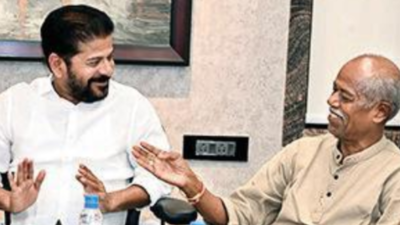- News
- City News
- Hyderabad News
- Congress, BRS strike dis'chord'ant note on 'Jaya Jayahe'
Trending
Congress, BRS strike dis'chord'ant note on 'Jaya Jayahe'

Ande Sri, who penned Jaya Jayahe, with CM Revanth Reddy
HYDERABAD: A day ahead of decennial celebrations of Telangana formation day, Congress and BRS on Saturday were at war over 'Jaya Jayahe Telangana' song, the official anthem of the state.
Even as the Congress govt is unveiling a new version of Jaya Jayahe Telangana on June 2 amid much fanfare, BRS has come up with its own 'Telangana Telugu Tejam' song.The Jaya Jayahe song also brought back bitter memories of Andhra-Telangana divide - seen during the statehood movement - with BRS supporters and Telangana activists questioning the selection of Oscar Award winner Keeravani to compose music for the song though he has Andhra roots.
At the centre of this seemingly unnecessary controversy was Telangana 'atma gouravam' (self-pride) - the pivot around which the statehood movement was championed by former CM and BRS president K Chandrasekhar Rao - coming to the fore again.
While Congress claimed that it granted Telangana, the BRS countered by saying then UPA govt gave Telangana due to its protracted statehood struggle for over a decade.
To counter this, BRS supporters have come up with Telangana special songs.
Out of Bengaluru shadows, Hyderabad a tech capital in the making
It has also emerged from the shadows of India’s Silicon Valley – Bengaluru. It generates a chunk of the new IT jobs and is also giving tough competition to Bengaluru as a GCC (global capability centres) powerhouse with over 300 GCCs across IT, BFSI, pharma, medtech, healthcare, semiconductors and automotives thanks to its skilled tech talent pool of around one million.
Today, it houses the largest GCCs of global giants like Apple, Amazon, Microsoft, Google, Meta, big pharma like Novartis, BMS, Sanofi, BFSI giants like Goldman Sachs, StateStreet, S&P, London Stock Exchange Group, semiconductor biggies like Micron and AMD and consulting firms like Deloitte.
But where does Hyderabad go from here? Former Nasscom vice president KS Vishwanathan feels it can do much more to cash in on the GCC surge. “Hyderabad currently gets about 17-19% of GCCs coming into India. It should target 25% but the goal should be 50% to become a game changer. The current brand image of Hyderabad should act as a catalyst,” he says.
Agrees Prof Ramesh Loganathan, head of research outreach at IIIT-H, former HYSEA president and former India head for Progress Software. “Hyderabad has reached that critical mass as the sentiment, which prevailed during the agitation, has changed. It has now become a default choice for MNCs looking at setting up GCCs.”
But to sustain momentum, Hyderabad needs to sharpen focus on R&D infrastructure, like Bengaluru, to attract more engineering design talent pool and create a niche as a hub for future technologies like Quantum technologies, AI & ML, Blockchain and EV tech, explains Vishwanathan.
like DRDO, BEL, ECIL and HAL Hyderabad still doesn’t have that R&D hub focus. It has a strong IT talent pool but needs to make it more diverse by creating as much capacities as possible in top four-five future technologies, not at the entry level but at the mid-level and PhD level to change the game,” Vishwanathan adds.
Pointing out that tech nology is becoming so disruptive that it will create more opportunities for newer companies, BVR Mohan Reddy, former Nasscom chairman and IT major Cyient’s founder chairman says, “That’s where innovation and startups come in.”
According to Loganathan, Hyderabad has leveraged its three main growth engines IT, pharma and aerospace & defence – to move up the value chain to research and innovation thanks to a strong academic innovation ecosystem comprising top ranking engineering institutions like IIITs and IITs, R&D institutions like CCMB, IICT and institutions like T-Hub and We-Hub.
“What we need is more homegrown companies as the real value will come from homegrown companies,” Loganathan says.
But there are some basics that need fixing and some pitfalls that need to be avoided, they feel.
“Innovation and startups require talent and a strong which we have and will ensure good talent availability for growth. We also have a fairly rounded tech industry and the mid-level management that will contribute towards startups in coming years. What we will need is more investor support,” says Mohan Reddy.
Even as the Congress govt is unveiling a new version of Jaya Jayahe Telangana on June 2 amid much fanfare, BRS has come up with its own 'Telangana Telugu Tejam' song.The Jaya Jayahe song also brought back bitter memories of Andhra-Telangana divide - seen during the statehood movement - with BRS supporters and Telangana activists questioning the selection of Oscar Award winner Keeravani to compose music for the song though he has Andhra roots.
At the centre of this seemingly unnecessary controversy was Telangana 'atma gouravam' (self-pride) - the pivot around which the statehood movement was championed by former CM and BRS president K Chandrasekhar Rao - coming to the fore again.
While Congress claimed that it granted Telangana, the BRS countered by saying then UPA govt gave Telangana due to its protracted statehood struggle for over a decade.
Congress govt, which came to power in the state in Dec 2023, planned to hold grand celebrations by unveiling a new state emblem and state song, written by Telangana lyricist Ande Sri. While it dropped the move to launch the emblem after its design drew criticism from various quarters, CM Revanth Reddy will dedicate the song to the people at a function at Parade Ground on Sunday.
To counter this, BRS supporters have come up with Telangana special songs.
Out of Bengaluru shadows, Hyderabad a tech capital in the making
It has also emerged from the shadows of India’s Silicon Valley – Bengaluru. It generates a chunk of the new IT jobs and is also giving tough competition to Bengaluru as a GCC (global capability centres) powerhouse with over 300 GCCs across IT, BFSI, pharma, medtech, healthcare, semiconductors and automotives thanks to its skilled tech talent pool of around one million.
Today, it houses the largest GCCs of global giants like Apple, Amazon, Microsoft, Google, Meta, big pharma like Novartis, BMS, Sanofi, BFSI giants like Goldman Sachs, StateStreet, S&P, London Stock Exchange Group, semiconductor biggies like Micron and AMD and consulting firms like Deloitte.
But where does Hyderabad go from here? Former Nasscom vice president KS Vishwanathan feels it can do much more to cash in on the GCC surge. “Hyderabad currently gets about 17-19% of GCCs coming into India. It should target 25% but the goal should be 50% to become a game changer. The current brand image of Hyderabad should act as a catalyst,” he says.
Agrees Prof Ramesh Loganathan, head of research outreach at IIIT-H, former HYSEA president and former India head for Progress Software. “Hyderabad has reached that critical mass as the sentiment, which prevailed during the agitation, has changed. It has now become a default choice for MNCs looking at setting up GCCs.”
But to sustain momentum, Hyderabad needs to sharpen focus on R&D infrastructure, like Bengaluru, to attract more engineering design talent pool and create a niche as a hub for future technologies like Quantum technologies, AI & ML, Blockchain and EV tech, explains Vishwanathan.
like DRDO, BEL, ECIL and HAL Hyderabad still doesn’t have that R&D hub focus. It has a strong IT talent pool but needs to make it more diverse by creating as much capacities as possible in top four-five future technologies, not at the entry level but at the mid-level and PhD level to change the game,” Vishwanathan adds.
Pointing out that tech nology is becoming so disruptive that it will create more opportunities for newer companies, BVR Mohan Reddy, former Nasscom chairman and IT major Cyient’s founder chairman says, “That’s where innovation and startups come in.”
According to Loganathan, Hyderabad has leveraged its three main growth engines IT, pharma and aerospace & defence – to move up the value chain to research and innovation thanks to a strong academic innovation ecosystem comprising top ranking engineering institutions like IIITs and IITs, R&D institutions like CCMB, IICT and institutions like T-Hub and We-Hub.
“What we need is more homegrown companies as the real value will come from homegrown companies,” Loganathan says.
But there are some basics that need fixing and some pitfalls that need to be avoided, they feel.
“Innovation and startups require talent and a strong which we have and will ensure good talent availability for growth. We also have a fairly rounded tech industry and the mid-level management that will contribute towards startups in coming years. What we will need is more investor support,” says Mohan Reddy.
End of Article
FOLLOW US ON SOCIAL MEDIA










